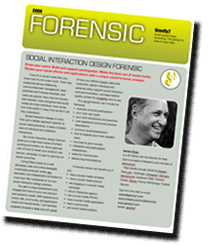The most common use of the term "social object" refers to shared online resources around which interactions develop and coalesce. Examples could include gifts on Facebook, videos, or what have you. The object sort of serves as a shared object, a focus of attention, an actual digital object, and so on. And the object plays a role in governing or informing interactions; we know what objects mean and what to do with them (give them, comment on them, play them, etc.)
But the definition of social object is a bit too fuzzy for me, and for a couple reasons.
Firstly, as designers, the object plays into our interest in having an object language -- things to design and design for. We are biased to think in terms of objects; objects belong to the world of interface design. So there is a possibility that where there is actually other stuff going on, we focus on the object out of our own interest. (By analogy, consider the anthropologist who focuses her attention on these social objects: a ceremonial mask, money, a wedding ring, a football. How much of the rituals, pastimes, social and cultural practices belong to the object and are explained by object properties? Not much....)
Secondly, objects are easily confused with their properties, attributes, qualities, uses, and so on. This is just how language works. We name a thing and give it attributes, and having done so we have a stable concept. Plato's ideal chair, vs all real chairs. Concepts then substitute for the real thing. It's possible that we're actually talking about the concept of social objects, and not social objects as used.
Which is a more accurate description of gifting on Facebook: the relationship between two friends and the practice of giving gifts on birthdays, or the graphic of the beer mug? The more accurate description of user interaction would be that which explains the practice of gift giving, the symbolic act of presenting a gift, the Facebook tradition of recognizing birthdays, and the social space in which gifts are seen by others such that birthdays create a cause for a stretch of social interaction.
We know that social objects are a shared cultural resource -- their meanings are culturally context-specific. We know that many social practices involve social objects. We know that in the digital domain, social objects are unique in that there is no original object but many copies; that an object can appear in many places at once.
For example, I give you a beer mug and it is on your wall but in my stream also -- same object, but not really, since one is the one I gave you and yours is the one you received. We're really talking about a representation, not an object. In other words, the object represents the act.
If the social object is sometimes the representation of an act, then perhaps the focus should be on the act, and on interaction practices, less on the object. The act of recognizing a friend's birthday by gifting a graphic beer mug is a better explanation of the user activity. The object is merely a representational vehicle by which the activity is sedimented into a mediated, visible, socially recognizable form.
Social objects, then, might be better understood as common forms. Forms in which many kinds of graphics, rich media, even textual forms (for a tweet is a social object as soon as it is retweeted) permit diverse kinds of social interaction. The object, in other words, is not an object, but a form.
If social objects are a form of representation, we can expand our understanding of what they mean. If a form has visual content, it is an image. If it has linguistic content, it is a text or an utterance. If it is a video, it is televisual.
If it is a gift using a graphic, such as the beer mug, then it is both a symbolic token (as described by traditions of gift giving -- the gift is an object with meaning inherited from the tradition of gift exchange, and specified by meanings belonging to the object: price, ownership, status, utility, etc) and an image. The beer mug graphic indicates "a drink" (this is basic theory of representation stuff: the image is a beer mug); the act of giving it refers to "get you a drink for your birthday". The interaction, in other words, is a symbolically-mediated one, referencing a content (get you a beer) and a cultural practice (on your birthday).
We can now see that the interaction situates and contextualizes the object. Not the other way around. The object doesn't tell us what's going on, nor does it define uses and interactions. Those belong to practices -- namely, practices in which objects are used.
There's another reason that the object should take a subordinate role to the interaction. Tweets are social objects. Tweets are utterances that take a form, and which, given that twitter is a distribution platform, can be circulated, referenced, recontextualized (posted to streams, blogs, surfaced in search, etc), and so on. We miss out on the significance of the "commodity" form of mediated talk if we think in terms of objects. Because we think of objects as things.
But clearly, anything that can be mediated and used as a shared resource can be a social object. And this includes tweets, things, and much more. So if the world of social objecst includes linguistic statements, gestural tokens (emoticons), signs, numbers (is a follower number a social object? it certainly is the object of a lot of social activity!), images, graphics, avatars, and on and on. We would have to admit that not only is the idea of social objects so broad as to be almost meaningless; but that it's lost any critical or explanatory power. A concept too big to give us any guidance.
So that's where I am on social objects. We need a better description. Personally, I think we can borrow from linguistics, semiotics, and anthropology. I would argue that the interaction domain has primary importance, and that the subdomain is symbolically-mediated interaction.
Within this, then, types include:
- linguistic statements
- symbolic tokens
- currencies
- representational objects
- images
- gestural signs
- signs
- numbers
- rich media (video, etc -- stuff playable online)
- bookmarks
- avatars
- etc
- linguistics for linguistic statements
- semiotics for signs
- representational theory for representations (looks like something) and images (is of something)
- cultural anthro for exchange practices and their token objects
- media theory for numbers (stats, counts, etc)
- and so on.
Labels: sxd





Comments: :
blog comments powered by Disqus
<< Home